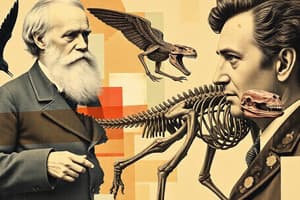Podcast
Questions and Answers
What was the key anatomical feature that Cuvier examined to differentiate between elephant and mammoth remains?
What was the key anatomical feature that Cuvier examined to differentiate between elephant and mammoth remains?
- Leg bone length
- Skull size
- Tusk curvature
- Tooth structure (correct)
What conclusion did Cuvier draw from the differences he observed in the skeletal remains of elephants and mammoths?
What conclusion did Cuvier draw from the differences he observed in the skeletal remains of elephants and mammoths?
- Elephants evolved directly from mammoths.
- Mammoths and elephants are the same species.
- Mammoths and elephants are distinct species, and mammoths are now extinct. (correct)
- Mammoths are a subspecies of modern elephants that migrated to colder climates.
Besides the differentiation of species, what broader historical significance did Cuvier's work on elephant and mammoth remains contribute to?
Besides the differentiation of species, what broader historical significance did Cuvier's work on elephant and mammoth remains contribute to?
- The methodology for dating fossils using radiometric techniques.
- The development of modern zoological classification systems.
- The understanding that species can become extinct. (correct)
- The foundation for genetic studies of ancient DNA.
How did Cuvier's findings challenge prevailing scientific beliefs of his time?
How did Cuvier's findings challenge prevailing scientific beliefs of his time?
If Cuvier had found transitional forms between elephant and mammoth remains, how might this have altered his conclusions?
If Cuvier had found transitional forms between elephant and mammoth remains, how might this have altered his conclusions?
What methodological approach did Cuvier primarily employ in his study of elephant and mammoth remains?
What methodological approach did Cuvier primarily employ in his study of elephant and mammoth remains?
How might modern genetic analysis enhance Cuvier's original conclusions about elephants and woolly mammoths?
How might modern genetic analysis enhance Cuvier's original conclusions about elephants and woolly mammoths?
Imagine a scenario where mammoth remains are discovered with soft tissue intact. How would this discovery affect the scope of scientific inquiry compared to just having skeletal remains?
Imagine a scenario where mammoth remains are discovered with soft tissue intact. How would this discovery affect the scope of scientific inquiry compared to just having skeletal remains?
How did Cuvier's work contribute to the field of paleontology?
How did Cuvier's work contribute to the field of paleontology?
Based on the quote, what is the most accurate interpretation of Georges Cuvier's view on the role of fossils in understanding Earth's history?
Based on the quote, what is the most accurate interpretation of Georges Cuvier's view on the role of fossils in understanding Earth's history?
Which intellectual shift does Cuvier's quote best exemplify in the context of 19th-century scientific thought?
Which intellectual shift does Cuvier's quote best exemplify in the context of 19th-century scientific thought?
How would a proponent of uniformitarianism likely critique Cuvier's perspective as presented in the quote?
How would a proponent of uniformitarianism likely critique Cuvier's perspective as presented in the quote?
Considering the historical context of Cuvier's statement, what underlying assumption about scientific inquiry is most challenged by his emphasis on fossils?
Considering the historical context of Cuvier's statement, what underlying assumption about scientific inquiry is most challenged by his emphasis on fossils?
How does Cuvier's quote implicitly address the concept of deep time?
How does Cuvier's quote implicitly address the concept of deep time?
In what way might Cuvier's emphasis on fossils challenge the philosophical doctrine of essentialism, which was prevalent during his time?
In what way might Cuvier's emphasis on fossils challenge the philosophical doctrine of essentialism, which was prevalent during his time?
How does the presented quote reflect Cuvier's contribution to the development of paleontology as a distinct scientific discipline?
How does the presented quote reflect Cuvier's contribution to the development of paleontology as a distinct scientific discipline?
Considering the broader impact of Cuvier's work, how did his emphasis on fossil evidence influence subsequent scientific debates regarding evolution and the age of the Earth?
Considering the broader impact of Cuvier's work, how did his emphasis on fossil evidence influence subsequent scientific debates regarding evolution and the age of the Earth?
What key principle did Cuvier use to reconstruct complete skeletons from isolated bones?
What key principle did Cuvier use to reconstruct complete skeletons from isolated bones?
How did Cuvier's observations of rock strata and fossils contribute to changing perceptions of Earth's age?
How did Cuvier's observations of rock strata and fossils contribute to changing perceptions of Earth's age?
Which of the following best summarizes Cuvier's primary contribution to paleontology?
Which of the following best summarizes Cuvier's primary contribution to paleontology?
Why was Cuvier's reconstruction of the pterodactyl significant?
Why was Cuvier's reconstruction of the pterodactyl significant?
How did Cuvier's theory of catastrophism explain the phenomenon of extinction?
How did Cuvier's theory of catastrophism explain the phenomenon of extinction?
What was the basis for Cuvier's conclusion that fossilized mammoth remains were distinct from modern elephants?
What was the basis for Cuvier's conclusion that fossilized mammoth remains were distinct from modern elephants?
How might Cuvier explain the presence of distinct fossil assemblages in different rock layers, according to his beliefs?
How might Cuvier explain the presence of distinct fossil assemblages in different rock layers, according to his beliefs?
How did Cuvier's stance on evolution influence his scientific interpretations?
How did Cuvier's stance on evolution influence his scientific interpretations?
What broader impact did Cuvier's work have on the scientific community's understanding of Earth's history and biological diversity?
What broader impact did Cuvier's work have on the scientific community's understanding of Earth's history and biological diversity?
Consider Cuvier's principle of 'correlation of parts.' Which of the following scenarios would best exemplify this principle?
Consider Cuvier's principle of 'correlation of parts.' Which of the following scenarios would best exemplify this principle?
Which statement best reflects the long-term impact of Cuvier's work on the study of natural history and geology?
Which statement best reflects the long-term impact of Cuvier's work on the study of natural history and geology?
How did Cuvier's position at the National Museum of Natural History in Paris directly facilitate his groundbreaking work on extinction?
How did Cuvier's position at the National Museum of Natural History in Paris directly facilitate his groundbreaking work on extinction?
What was the prevailing scientific belief regarding fossils before Cuvier's contributions, and how did his research challenge this view?
What was the prevailing scientific belief regarding fossils before Cuvier's contributions, and how did his research challenge this view?
In what way did Georges Cuvier's background and education at the Caroline Academy in Stuttgart influence his later work in comparative anatomy and paleontology?
In what way did Georges Cuvier's background and education at the Caroline Academy in Stuttgart influence his later work in comparative anatomy and paleontology?
How did Cuvier's work on marine invertebrates contribute to his broader theories about the classification of organisms and the nature of life on Earth?
How did Cuvier's work on marine invertebrates contribute to his broader theories about the classification of organisms and the nature of life on Earth?
What distinguishes Cuvier's approach to understanding Earth's history from earlier perspectives?
What distinguishes Cuvier's approach to understanding Earth's history from earlier perspectives?
What implications did Cuvier's theory regarding past natural disasters affecting Earth's geological structure have on the scientific community's understanding of geological processes?
What implications did Cuvier's theory regarding past natural disasters affecting Earth's geological structure have on the scientific community's understanding of geological processes?
How did Cuvier's reconstruction of skeletons from fossilized remains during his lectures in Paris impact both the scientific community and the general public?
How did Cuvier's reconstruction of skeletons from fossilized remains during his lectures in Paris impact both the scientific community and the general public?
What was the crucial role of comparative anatomy in Cuvier's methodology, enabling his conclusions about extinction and the classification of organisms?
What was the crucial role of comparative anatomy in Cuvier's methodology, enabling his conclusions about extinction and the classification of organisms?
What was the significance Cuvier's 1796 comparison of elephant and mammoth bones, and why was it considered so revolutionary?
What was the significance Cuvier's 1796 comparison of elephant and mammoth bones, and why was it considered so revolutionary?
Flashcards
Georges Cuvier
Georges Cuvier
A French zoologist who founded paleontology.
Comparative Anatomy
Comparative Anatomy
A scientific discipline studying similarities and differences in animal structures.
Proves Extinctions
Proves Extinctions
Cuvier's conclusion that some species no longer exist.
Age of the Earth
Age of the Earth
Signup and view all the flashcards
Animal Taxonomy
Animal Taxonomy
Signup and view all the flashcards
Geological Structure
Geological Structure
Signup and view all the flashcards
National Museum of Natural History
National Museum of Natural History
Signup and view all the flashcards
Theory of Extinction
Theory of Extinction
Signup and view all the flashcards
Lectures in Paris
Lectures in Paris
Signup and view all the flashcards
Marine Invertebrates
Marine Invertebrates
Signup and view all the flashcards
Extinction
Extinction
Signup and view all the flashcards
Correlation of Parts
Correlation of Parts
Signup and view all the flashcards
Animal Reconstruction
Animal Reconstruction
Signup and view all the flashcards
Catastrophism
Catastrophism
Signup and view all the flashcards
Paleontology
Paleontology
Signup and view all the flashcards
Fossil Analysis
Fossil Analysis
Signup and view all the flashcards
Rock Strata
Rock Strata
Signup and view all the flashcards
Hoofed Mammals
Hoofed Mammals
Signup and view all the flashcards
Scientific Revolution
Scientific Revolution
Signup and view all the flashcards
Cuvier
Cuvier
Signup and view all the flashcards
Elephants
Elephants
Signup and view all the flashcards
Woolly Mammoths
Woolly Mammoths
Signup and view all the flashcards
Tooth Structure
Tooth Structure
Signup and view all the flashcards
Distinct Species
Distinct Species
Signup and view all the flashcards
Skeletal Remains
Skeletal Remains
Signup and view all the flashcards
Fossil Evidence
Fossil Evidence
Signup and view all the flashcards
Fossils
Fossils
Signup and view all the flashcards
Theory of Earth's formation
Theory of Earth's formation
Signup and view all the flashcards
Quote significance
Quote significance
Signup and view all the flashcards
1830s geology
1830s geology
Signup and view all the flashcards
Scientific observation
Scientific observation
Signup and view all the flashcards
Geology and paleontology connection
Geology and paleontology connection
Signup and view all the flashcards




